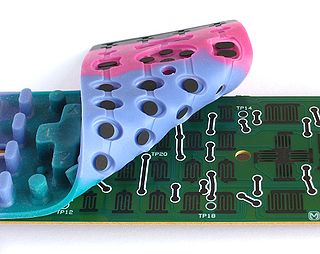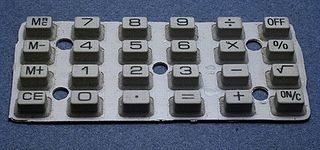- Chiclet keyboard
-
 Keyboard from a remote control. When the key is pushed down, the conductive material on its underside touches the pair of fork-shaped traces below, bridging the gap between them and closing the circuit.
Keyboard from a remote control. When the key is pushed down, the conductive material on its underside touches the pair of fork-shaped traces below, bridging the gap between them and closing the circuit.
A chiclet keyboard or island-style keyboard is a computer keyboard built with an array of small, flat rectangular or lozenge-shaped rubber or plastic keys that look like erasers or "Chiclets", a brand of chewing gum manufactured in the shape of small squares with rounded corners. Most often the tops of the keys were hard, but sometimes they were made of the same material as the rubber dome itself. For example, the keys on Sinclair ZX Spectrum computers were "rubber dome keys" which were sometimes described as "dead flesh",[1] while the "American" version of the Timex Sinclair 2068 was described as having "chiclet keys".[2] Chiclet keyboards are characterized by having each key surrounded (and held in place) by a perforated plate, so there is a space between the keys.
Since the mid-1980s, chiclet keyboards have been mainly restricted to lower-end electronics, such as small handheld calculators, cheap PDAs and many remote controls.
The term has also been used more recently to describe several popular low-profile, low-travel keyboards. These keyboards have small, flat, squarish keys that are separated from each other by some space on the baseplate they protrude from - a feature common to the old chiclet keyboards. They are not chiclets in the earlier sense, however, as they do not use a rubber membrane or directly moulded hard key tops as the keys themselves and instead use a more modern technology.
Design
In some (but not all) versions of the chiclet keyboard, the bottom three layers are essentially the same as those in the membrane keyboard. In both cases, a keypress is registered when the top layer is forced through a hole to touch the bottom layer. For every key, the conductive traces on the bottom layer are normally separated by a non-conductive gap. Electrical current cannot flow between them; the switch is open. However, when pushed down, conductive material on the underside of the top layer bridges the gap between those traces; the switch is closed, current can flow, and a keypress is registered.
Unlike the membrane keyboard, where the user presses directly onto the top membrane layer, this form of chiclet keyboard places a set of moulded rubber keys above this. With some key designs, the user pushes the key, and under sufficient pressure the thin sides of the rubber key suddenly collapse. In other designs — such as that seen in the diagram — the deliberate weak point is where the key joins the rest of the sheet. The effect is similar in both cases, however.
This collapse allows the solid rubber center to move downwards, forcing the top membrane layer against the bottom layer, and completing the circuit.
The "sudden collapse" of the chiclet keyboard (along with the movement of the key) provides a greater tactile feedback to the user than a simple flat membrane keyboard.
 Stylised cross-section of a Chiclet keyboard. The thickness of the bottom three layers is exaggerated for clarity; in real-life they are not much thicker than paper. Note the distortion of the thin rubber where the right-hand key (pressed) joins the sheet. Some designs omit the top membrane (green) and hole (black) layers, instead coating the undersides of the keys themselves with conductive material (red).
Stylised cross-section of a Chiclet keyboard. The thickness of the bottom three layers is exaggerated for clarity; in real-life they are not much thicker than paper. Note the distortion of the thin rubber where the right-hand key (pressed) joins the sheet. Some designs omit the top membrane (green) and hole (black) layers, instead coating the undersides of the keys themselves with conductive material (red).
Other versions of the chiclet keyboard omit the upper membrane and hole/spacer layers; instead the underside of the rubber keys themselves have a conductive coating. (This is the type shown in the photograph of the remote control, above). When the key is pushed, the conductive underside makes contact with the traces on the bottom layer, and bridges the gap between them, thus completing the circuit.
The dome switch keyboards used with a large proportion of modern PCs are technically similar to chiclet keyboards. However, the rubber keys are replaced with rubber domes, and hard plastic keytops rest on top of these. Because the keytops are wider than the rubber domes the keytops are not separated but align almost perfectly with only a minimal gap in between each other.
List of notable computers with chiclet keyboards
All of the computers listed hail from the early home computer era, except the OLPC XO-1.
- Atari Portfolio (its keys resembled those of a HP pocket calculator)
- Cambridge Z88 (arguably a mix between a membrane and chiclet keyboard)
- Commodore PET 2001 (the original 1977 PET) had the square keys of a calculator or cash register.
- Commodore 116 (version of the C16 sold only in Europe)
- Enterprise 64 (had a rubber keyboard, on top of which plastic keycaps were glued)
- IBM PCjr [3]
- Jupiter ACE (Sinclair spectrum style black rubber keys)
- Mattel Aquarius (blue rubber keys)
- Microdigital TK 90X (Brazil ZX Spectrum derivation)
- Multitech Microprofessor I (MPF 1) and MPF II (the latter an early Apple II compatible)
- OLPC XO-1 (green rubber keys molded from a single sheet of rubber)
- Oric-1 (hard key tops glued on a rubber sheet, somewhat resembling the PCjr)
- Panasonic JR-200
- Sinclair ZX Spectrum 16/48K (later models had slightly improved keyboards)
- Spectravideo SV-318
- Tandy TRS-80 Color Computer I (later 'CoCo's had full-travel keyboards)
- Tandy TRS-80 MC-10 and its French counterpart, the Matra Alice
- Texas Instruments TI-99/4 (predecessor of the TI-99/4A, which had a full-travel keyboard)
- Thomson MO5 (French microcomputer based on the 6809 microprocessor)
- Timex Sinclair 1500 (U.S. ZX81 derivation)
- Timex Sinclair 2068 (U.S. ZX Spectrum derivation)
- VTech Laser 200 (also known as the Video Technology VZ200)
- Some early models of MSX computers, for example the Philips VG-8010[4]
References
- ^ "Sinclair ZX Spectrum". ComputerMuseum.50megs.com.
- ^ "The Timex-Sinclair 2068. (evaluation)". Owen W. Linzmayer, Creative Computing Vol. 10, No. 3. March 1984. p. 93. (atarimagazines.com).
- ^ "Chicklet Keyboard frm IBM PC Jr". DigiBarn Computer Museum.
- ^ "Philips VG 8000 / 8010". oldcomputers.com History of Home and Game Computers. Erik Klooster.
This article was originally based on material from the Free On-line Dictionary of Computing, which is licensed under the GFDL.
Categories:- Home computers
- Computer keyboards
Wikimedia Foundation. 2010.

